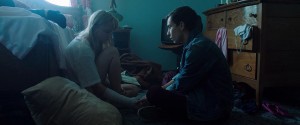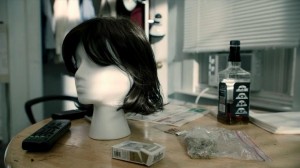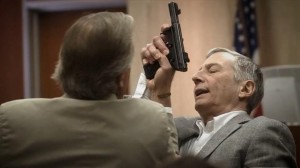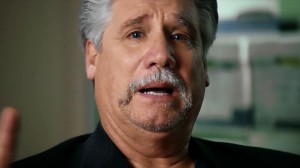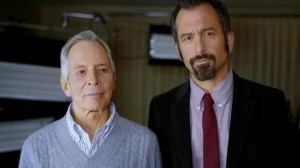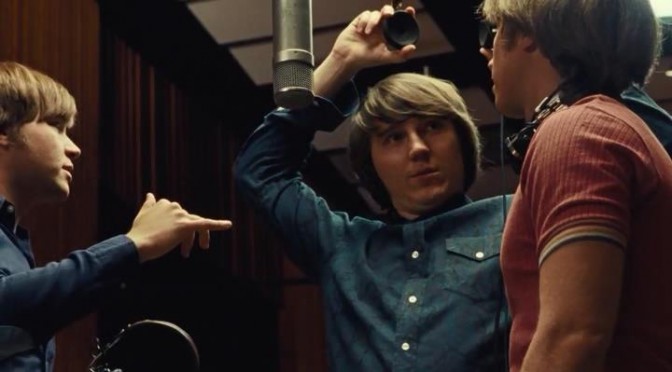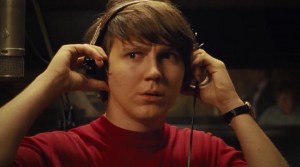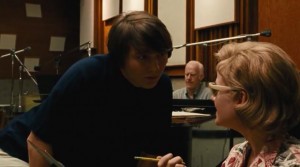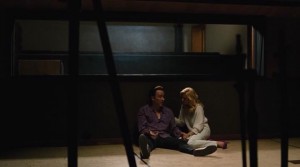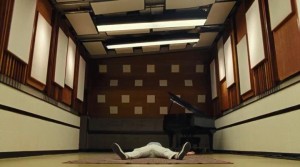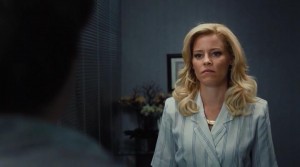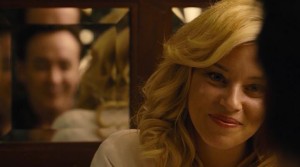Around this time two years ago, I was writing a year-end review for my fourteenth favorite film of a 2013, one of the two best film years of this century. The film was James Ponsoldt’s The Spectacular Now, the marvelously nuanced and tender romantic drama set in an American high school. That lovely, observant teenage film further confirmed the immense talent of Shailene Woodley and introduced me to the dynamic and charismatic Miles Teller. I was moved more than I ever could have expected by how frankly and empathetically it entered the world of its adolescent protagonists and how thoughtfully it observed them. So few directors show anything more than a passing concern in understanding their teenaged characters beyond a surface level. It gave me new hope for that an adult filmmaker could place himself in the shoes of his young characters and relate their stories with clear, sympathetic eyes. As I was writing that review, the Sundance Film Festival was screening the debut of 2014’s tremendously scary and moving Austaralian horror film, The Babadook. In recent years, starting perhaps with 2012’s Cabin In the Woods, there has been a hushed excitement that the horror genre is starting to brim with exciting, vital films again, and The Babadook is a huge part of that burgeoning horror renaissance. I saw The Babadook last year and loved it. It was my fourth favorite film of its year, and I adored it for reasons not dissimilar to those that made me love The Spectacular Now. Both high school films and horror films have a tendency toward recycling familiar tropes and plot points. And, at their worst, they tend to fall back on tired archetypes who move the plot forward, but have very little agency or personality of their own. Even with the main characters, it can often seem like they are there to serve a pre-existing story that is already in place rather than to have an organic narrative crafted around their desires and inner lives. Both The Spectacular Now and The Babadook scratched a similar cinematic itch for me. They found oceans of soul and insight inside worlds that had been visited countless times before, and they invested heavily in phenomenally gifted actors who could render familiar characters with subtle specificity. However, in spite of how much they have in common as unexpectedly great films inside their respective genres, I never thought to compare them until now. I have waited with baited breath for the next film to portray teenagers with the grace and genuine care of The Spectacular Now, and I have waited just as eagerly for the next horror film with the perfectly judged style and emotional wallop of The Babadook. I just never thought that one movie would be the next to achieve both feats. It Follows, David Cameron Mitchell’s ingenious and meticulous horror film, is the best film about teenagers since The Spectacular Now (excepting a certain laidback masterpiece from 2015), and it is also The Babadook’s proud successor in the new, and hopefully long, horror revival.
It Follows begins with a breathtakingly intense prologue. Annie, a young woman in her late teens runs out of her house. She stands in the middle of the suburban street, visibly shaken. Her neighbors and her own father ask if she is okay. She tries to ease their concern, but her gaze is always at some unseen thing in front of her. She sprints back into her house and emerges a moment later with the keys to her car. In an instant, she is tearing off through the fading dusk. She parks her car on the beach and sits in the darkness with her back to the ocean. She calls her parents to tearfully apologize for anything she ever did to hurt them. When the morning sun comes up, she lies dead on her back. Her left leg has been snapped backwards over her head and her face is a frozen mask of pain. After this enigmatically unsettling introduction, It Follows finds its true protagonist and becomes the story of Jay, a college student in her early twenties. She is played by Maika Monroe in the kind of simple, unshowy performance that I appreciate more each time I see it. It is also the story of her sister, Kelley, and their small circle of friends, which includes their former stepbrother Paul, and Yara, a sardonic bookworm with a low-key demeanor. Jay and Kelley live in their family home with a mother who is glimpsed only occasionally, and who only has one speaking scene in the entire movie. For the most part, the small circle of friends talks only among themselves. When we meet Jay, she is preparing to go on a date with a young man named Hugh. As they stand in line to see an old Cary Grant film, Jay proposes a game. Hugh must look around and pick the person in the crowd who he would most want to be. He chooses a six-year old child, because he is momentarily free from responsibility, fear, and the consequences of getting older. As Hugh attempts to guess Jay’s pick, he points to a girl in a yellow dress at the back of the theater. Jay is unable to see her. Hugh flies into a panic and runs out of the movie, dragging Jay behind him. On their second date, Jay has sex with Hugh in hi car. Afterwards, she leans out of the open door of the backseat and muses about how she always thought about adult milestones like this when she was a small child; not only about sex, but about the whole gamut of grownup freedom. Now that all that autonomy is hers, and all the mysteries behind the adult veil have been revealed, she wonders what is left to want and to look forward to. At that very moment, Hugh forces a chloroform-soaked rag over Jay’s mouth, and Jay wakes up on the second floor of an abandoned commercial building, tied down in a rolling chair. Hugh explains It Follows’ ingenious horror concept. Now that Jay has had sex with him, a shapeshifting entity will follow her. It will kill her if it catches her. It can take any human form it wishes, even that of people she knows and loves. It will only walk after her. It will never speak. But it is not stupid. Jay will need to be wary of entering rooms with only one door. It will only cease following her when she passes it off to another sexual partner. However, if that partner dies, it will come back down the chain to resume hunting her. Hugh shows her the spectre. It is slowly walking along the perimeter of the building, in the form of a half-dressed woman. Within a minute, it has found a way up to the same floor as them. Hugh takes Jay away and drops her off in front of her house, trembling and still in her underwear. It Follows is the story of Jay coming to terms with the grim avatar chasing her and how she turns to her sister and close friends (including Greg, a broodingly sensitive neighbor boy, who offers his beach house as refuge) to help her outsmart the implacable threat. It Follows is a coming-of-age horror film, about a small social unit facing down adulthood, sex, and death together.
As an adult making a film about teenagers, David Cameron Mitchell strikes a delicate balance. He allows the story to unfold with an adolescent’s sense of anxiety and uncertainty about sex, but he also brings an adult’s maturity on the subject. It is the same maturity the characters steadily find as they go through this ordeal together. 2015 was the year that the term “sex-positive” happily entered my vocabulary. I have long felt troubled by how pervasively sex is stigmatized in our culture. One of the most surprising facets of It Follows, a film where teenaged sex literally creates an unyielding monster, is how frank and positive it is about sex under the surface. The sex act may be what puts Jay in danger, but the film does not view sex itself as negative. Sex is a powerful, multi-faceted thing; a force of both light and darkness. It Follows is very much a film about sexual fear and curiosity and the different ways young people come to reconcile its power to both harm and heal. While the monster may tie neatly to the idea of sexually transmitted disease, the film crafts a much more complex metaphor, which takes on the emotions of sex as well as the physiology. Sex is a force of nature, and Hugh’s advice to Jay is to distance herself from that force as much as possible by spreading it to the next partner she can find. Hugh’s method of diminishing the staggering and sometimes frightening emotional power of sex may be to simply engage in it as often as possible until it is no longer has the terrible power of the unknown. I should note here that It Follows heavily suggests sexual abuse somewhere in our characters’ pasts. Hugh’s approach seems to be a kind of proactive survival mechanism: flipping all the lights on and staring the monster down until it cannot scare or hurt us anymore. While sex is the only means of delaying the monster, however, Mitchell suggests that turning to our loving relationships may be the surer means of survival.
It Follows has such a terrifically scary concept that it likely would have been an interesting and worthy film, even if it was just about how terrifying the idea of sex can be to a young person. Thankfully, it becomes a great and thoughtful film because of how it contrasts the idea of sex as a sinister and alienating force with the idea that sex is a means of fostering love and human connection. Jay’s predicament is not the result of sexual activity, but the result of sex with a man who was only interested in distancing himself from some past hurt he suffered. In contrast to her experience with Hugh, Jay comes to find a genuinely loving connection in Paul, who not only wants to be with her but wants to share her monstrous burden. It Follows does not propose any easy solution to the problems brought on by abuse and sexual dysfunction, but it argues that fostering sexual relationships based on open communication and mutual care for one another is probably the best place to start. This is how a horror movie about what is effectively a sexually transmitted demon ends up being one of the year’s most psychologically honest and emotionally healthy films.
The joys and terrors of sexual awakening are the chief subject of It Follows, but its thematic scope is more expansive than that. It is a horror movie where the terror is the entire fear of growing up, growing old, and dying. It is partly about the fear of mysterious rites of passage like sex, but it is also about dreading that life will no longer have any mystery. It is about being a young person standing at the city limits of adulthood and remembering how long you have been sheltered from seeing this place. Mitchell smartly fills the film with the iconography of childhood’s innocence: swimming pools and ice cream parlors, playgrounds and beach houses. However, the fear Jay and her friends feel is not simply the anxiety that comes from seeing their lazy summer days become less carefree, but from finally being able to glimpse the end of all their days. It is about the fear of disappointment and death, and how those two feed off of one another. There is a reason that one of Jay’s first encounters with the monster takes place in a college English course, as the professor reads The Love Song of J. Alfred Prufrock, T.S. Eliot’s famous poem where the narrator’s fear of his inevitable demise is only secondary to the fear that he will die a forgotten footnote. Like that poem, It Follows is a spiritual paranoia that goes much deeper than sex. Jay and her inner circle are thoughtful, smart, yearning young adults, and, like so many hyper-intelligent young people, they feel the full weight of the world. They feel it in spite of their tender age, and probably because of it as well. Every child thinks of death, but there comes a moment when that idea of mortality transforms from a storybook apparition into something concrete; something with real, physical contours. Mitchell knows that this is something every young person feels, but he also understands how Jay and her friends feel like they are alone in confronting these new emotions.
It Follows thoughtfully tackles sex and growing up, but what makes it a great film is how it uses impeccable cinematic technique to both support its themes and create beautiful tension as a piece of horror filmmaking. If one just wants to watch one of the most chilling and ominously beautiful works of recent genre cinema, It Follows is worth seeing for its technical accomplishments alone. Mitchell has a great, playfully sadistic sense of timing. He knows when and how to have the monster appear from moment to moment. In one scene, the monster takes Yara’s form and walks up behind Jay on the beach. To the viewer, there is nothing to indicate that this is not Yara. Then, far off in the background, the real Yara drifts into the frame in an inner tube. The electronic artist Disasterpiece crafts a moody 80’s synth score that lovingly sends up John Carpenter films like Halloween, but also does a tremendous job of enhancing the mood of this modern film. It is rare case of homage done well; paying respects to a past horror master while remaining a seamless part of this new horror classic. Most of all, It Follows is a tremendous work of cinematography. The shots Mitchell sets up are meticulous and beautiful in their sense of foreboding, from the horrific tableau-like shot of the monster’s first victim mutilated on the beach to the unsettling pan around the Jay’s college quad, where each and every body the camera sees could be the monster.
But Mitchell is such a confident director that these painterly shots are always feeding the emotions and ideas of the film too. In the film’s opening scene, the first victim waits for the monster on the beach, bathed in the headlights of her car. She sits in the center of the frame, but the very wide shot makes her look miniature. Mitchell uses this shot to create a feeling of insignificance and isolation. We feel for this poor young girl not only because death is pursuing her, but because the camera communicates how alone she is. In perhaps my favorite shot of the film, Jay runs away from the beach, as the monster pursues her across the front yard of Greg’s house. Panicked and afraid, she hops in Greg’s car and pulls forward to make a three-point turn. We momentarily lose sight of the monster walking across the yard as the beach house enters the frame. When Jay reverses and then speeds away from the house, we can see the yard again; except the monster is gone and we only see her friends in the far distance running after the car. It is not only the most impressively virtuosic shot in the movie, but conveys what all this fear and dread can do to a young person. It can send them running off into solitude, away from the people who most care about them. It Follows explores the adolescent feeling of battling force no one else can see. Adults are barely ever seen in the world of this film, even though we know that Jay and her friends have parents. Any adult we do see is just as likely to be the monster as a real human being. Being young can feel like being on a strange, barely inhabited planet.

It Follows is a horror movie, but it is unlike a great many horror movies in its refusal to use young characters as bland fodder. Many films of this kind watch voyeuristically as the young scatter from one another to die somewhere alone in the woods, but the characters in it Follows press close together. The young characters of It Follows learn that adulthood brings a host of new fears and dangers, but their arc is more about the stalwart courage they find in each other than about despair over what the future holds. Connection and solidarity is what sees them through. I have heard adults bemoan how rapidly advancing technology and social media have flooded world with strange new modes of communication. I can remember hearing about text speak for the first time and dismissively thinking of it as a bizarre code system used only by the young. And of course it was! Adults forget too quickly what a daunting, desolate space adolescence is. We traversed that alien expanse ourselves not so long ago. We felt afraid and misunderstood, but people who were like us, placed in that exact same situation at that exact same time. They spoke the same language as us. Films like It Follows remember that feeling and they call for us to remember it too. I still feel foolish for making fun of text speak. The young will always need their codes. And each other.




